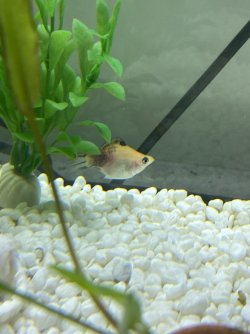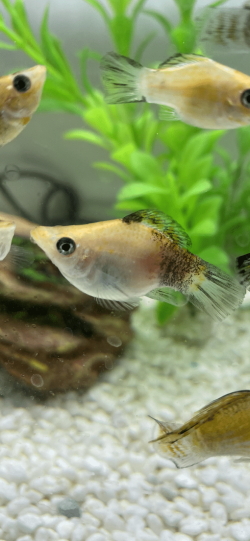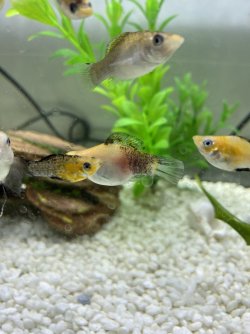Hi
@jellybellyfish , I'm sorry that you've experienced a bit of a rough introduction to the hobby! It's not your fault, but you've been sold a "variety" of fish that is deliberately bred from deformities for a certain look. It's an unethical practice, and they're sold to people without any warning about the health problems that come with these fish.
Whoops, I hit enter instead of quote. I did go and read the threads from your previous threads and grabbed quotes from the experienced and expert folks we're lucky to have here:
I'll start by saying 99.9% of new aquarists don't know why a balloon is shaped as it is. The fish has a serious spinal deformity, cultivated by fish farms because it sells well. So she is squaring off, as breeders say - it's a shape seen not long before she drops her fry. With her severe scoliosis, the shape is kind of wonky.
Personally, and this is just a stranger on the internet talking, I wouldn't raise the fry as they will have the same genetic disease. A lot of female balloon mollies die giving birth, or soon after. I hope she's one of the lucky ones.
Well, not all females will have this squared off shape before dropping fry. Once it starts to get squared off, it means that she's used her max gestation period (which is longer than the average gestation period).
It looks more worse when a balloon molly (same goes for the balloon guppy and balloon platy) will square off because of the already cramped shaped body. Like most serious livebearer lovers, I dislike the such balloon livebearers when it comes to their shape and health issues.
The fish is a balloon molly and their body is less than half the length of a normal molly. This causes their internal organs to get squished up and they have a lot more internal problems.
Mollies and other common livebearers from Asia usually have gill flukes and intestinal worms. The fish has stringy poop and this is often a sign of worms.
Gill flukes can damage the gills and cause them to go redder than normal or real pale pink if the fish is running low on blood.
Floating about can be a swim bladder problem or air in the intestine. With deformed fishes like balloon fish and fantail goldfish, the air gets ingested when they feed from the surface and trapped in their intestine. If the fish is fed a variety of foods (in particular frozen and live) they don't normally have this issue. The way to test for a swim bladder problem is to stop feeding dry food and only give the fish frozen or live food for a week. If they stop floating about then the issue is air in the intestine. If it doesn't improve after a week without dry food, then it has a swim bladder problem.
Section 3 of the following link tells you how to treat fish for intestinal worms. Some deworming medications (Praziquantel & Flubendazole) also treat gill flukes.
Fish do a stringy white poop for several reasons. 1) Internal Bacterial Infections causes the fish to stop eating, swell up like a balloon, breath heavily at the surface or near a filter outlet, do stringy white poop, and die within 24-48 hours of showing these symptoms. This cannot normally be...

www.fishforums.net
Could be a swimbladder problem which is a kind of normal that they can have this problem as being a balloon molly. Everything is cramped in its body. Balloon mollies, balloon platies, balloon guppies and lyretail goldfish have the this problem quite often at some point. There's no real cure for balloon fish when having this problem. Not even a boiled pea could help you out if it's swimbladder problem. Which it most likely is. Sorry to say...
It could be air trapped in the fish's intestine. This happens a lot with deformed fishes like balloon mollies and fantail goldfish when they eat dry food. they ingest air at the same time and it builds up in their intestine and causes them to have trouble remaining bouyant.
To test this, stop feeding dry food for 1 week and feed frozen or live foods instead. If the problem goes away, then the dry food is causing the problem and you will need to feed less dry and more frozen foods.
If the problem persists after a week without dry food, then it has a swim bladder problem and there is no cure for that.
In future, try to avoid buying balloon fishes because they have a much shorter life span than normal shaped fish.
Hi there,
Please find attached the link to the YouTube video of my fish and fish tank
I agree with all of the wise men above, it's a sad fact that these fish are sold because some people find them cute and appealing, but the fish are actually serious deformed, which causes a lot of health issues. To add to the problem, they are cheap mass farmed fish and even the non-deformed versions of mollies (the normal ones, not "balloon" ones) are also often riddled with worms and other illnesses before they even arrive in the store tanks, then sold to unsuspecting new hobbyists who don't know why their fish are all dying.

In my honest opinion, I would return the fish to the store if you can. Balloon fish are always going to have huge internal health problems because of the squished shape, and you will continue to have to witness fish dying and the stressed and unhappy looking fish you currently have. None of that is a failing on your part. This is the fault of these fish being produced and sold. If you want a nice, peaceful and healthy aquarium, you won't be able to have it with balloon fish, I'm sorry.
I would personally return them, make it the stores problem, and start over. We can help you through the process of setting up the tank properly and choosing healthier fish that you can cultivate a healthy environment for, and be able to enjoy having a tank and fish without having to constantly deal with the upset and losses that you would continue to experience if you keep trying with these balloon fish. Since your tank has been set up and stocked since Jan(? It looks like a brand new tank, very clean!) you could restock without having to go through the cycling process again!
Thank you for the video, it really is helpful! It's a cute tank, but there are some things I noticed and you can easily resolve! If you choose to keep these fish, you could take the following steps to try to give them the nicest tank you can. I wouldn't continue to breed them, it's not ethical given their deformities, so at least think about returning the females and fry, and keeping only the males. Those are still deformed, but at least you won't be producing more fry by continuing to allow them to breed in a mixed sex community tank.
First, in my opinion the fish look "wormy" to me. That thin smaller one struggling to swim is dying, I'm sorry. The redness you've been noticing around the gills and in the body of that fish I think are just because the colouring of the fish has their internal organs more visible than in many fish, so you're worrying about injuries or gill flukes when I think you're just seeing the gills and internal organs through the skin. But the fish are not thiving and some are struggling and passing away because of their deformities, and a heavy worm load. In the quotes above
@Colin_T linked the worming thread which is important to know what medicines to get in order to eliminate both roundworms and flatworms. They're likely to have both, so I would treat for both, then return the females and fry.
The tank is too open - put a background on the back of the tank, and more cover for the fish to hide in will make them feel a lot safer, and they will colour up better and be less stressed if you introduce more plant cover, ideally live plants and including some floating plants, and a background so the fish don't feel so exposed and stressed. Treating the worms should help a lot, the minor and easy improvements to the tank environment will help and give the fish the best home you can. Keep the water clean and fresh with regular weekly water changes and watch the stocking levels as they have produced fry which rapidly grow the population!
I wish you luck whatever you decide to. I'm sorry we have to tell you the bad news about this type of fish, but you clearly care about your fish and want to do your best for them! It isn't your fault that these were sold to you, but you could have a lovely tank and healthy fish if you're willing to restock. We're happy to help where we can.









